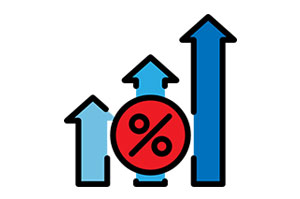You can’t rely on luck if you want to be successful at day trading. The market is constantly changing as trading days pass; if you can’t maximize your profits during a set time period, you’re unlikely to make a solid profit.
If you want to be amongst the many successful, wealthy day traders, then you’ll need to learn how to analyze—and act up—the intraday charts!
Active traders use many different metrics—such as the buying price and adjusted price—to analyze and select stocks; one such technical indicator is the VWAP (i.e., Volume Weighted Average Price).
Although the term itself sounds complex, it’s actually relatively easy to calculate this key metric. By the end of this article, you’ll know how to calculate the VWAP of a stock!
What is the Volume Weighted Average Price?
The volume weighted average price is a technical indicator that helps traders follow the direction of intraday prices. “Typical price” is calculated using the entire day’s worth of data (high, low, and closing price).
Similarly, the VWAP is generally calculated using trading volumes and price action from a select period of time. This data could be gathered over an entire day or in a matter of minutes! The process begins the same as typical price calculations but adds a few extra steps at the end.
Many experts recommend against using VWAP when trying to analyze trends over multiple trading days. The formula is most effective when used for short-term calculations.
Who Uses VWAP?
Both traditional VWAP (all market hours included) and anchored VWAP (time-specified) are often utilized by individual traders. VWAP is especially useful for day traders, who can analyze the price of trades to find the most favorable price to buy/sell.
This technical indicator is also used by institutional traders, such as mutual funds. Since these institutions often buy/sell thousands of shares, they can easily accidentally affect the current price of an asset. Fortunately, analyzing VWAP calculations can help them avoid doing this.
Buying below the VWAP or selling above the VWAP are both ways to minimize the influence of large trades on the market. Although not always feasible, companies generally try to do this when possible.
Learning More About Technical Analysis
Investors Underground is an online educational community worth checking out if you’re curious about learning the technical ins and outs of day trading. Its trading strategy is primarily focused on utilizing the volume weighted average price to anticipate trades. However, it also incorporates many other useful technical indicators—such as relative strength index (RSI) and moving average converse divergence (MACD)—into their calculations!
VWAP Calculation
So, now you know what volume weighted average price is (and how it differs from the typical price), but you’re probably wondering how to calculate it. Let’s take a look using the example VWAP calculation shown below!
To start, we’ll need to choose a period of time for our calculation. This could be a matter of minutes, hours, or all day. Let’s just assume the time period is five minutes (out of six hours so far) for the sake of this example.
Looking at the data from this time period, we see a wide price range on stock “X”:
- A high of $450
- A low of $130
- A close of $320
We’ll add these values together, leaving us with $900. Next, we’ll divide this number by 3, which comes out to an even $300 (average price).
Now, we need to look at the volume. During the last five minutes, there have been 50 trades. However, there have been 8,000 trades in the last six hours!
Take the 300 from earlier, and multiply it by the interval volume during the time period we’ve analyzed (50 trades, five minutes). This comes out to 15,000. Finally, divide this number by the cumulative volume (8,000). We’ve determined that the VWAP is 1.875!
Volume Weighted Average Price: A Summary
Confused by the section above? Here’s a simple formula to help you figure it out! Just remember that the:
- Interval volume is the total number of trades from the specific time interval you’re analyzing.
- Cumulative volume is the total number of trades from the entire trading session.
Volume Weighted Average Price: A Summary
For both individual and institutional investors, utilizing intraday VWAP calculations can be extremely beneficial to implement a successful trading strategy. Thankfully, many technical analysis tools are capable of calculating traditional VWAP and other metrics, streamlining the entire algorithmic trading process. This means traders don’t need to waste valuable seconds manually performing calculations by hand.
Although VWAP is very similar to the typical price, it offers the advantage of time-specific information. It’s this attribute that makes it invaluable to day traders, who must make the most out of every second if they want to enjoy significant returns. If you’re not already using VWAP calculations, it’s high time you start: potential profits are waiting!
Image and article originally from www.modestmoney.com. Read the original article here.

